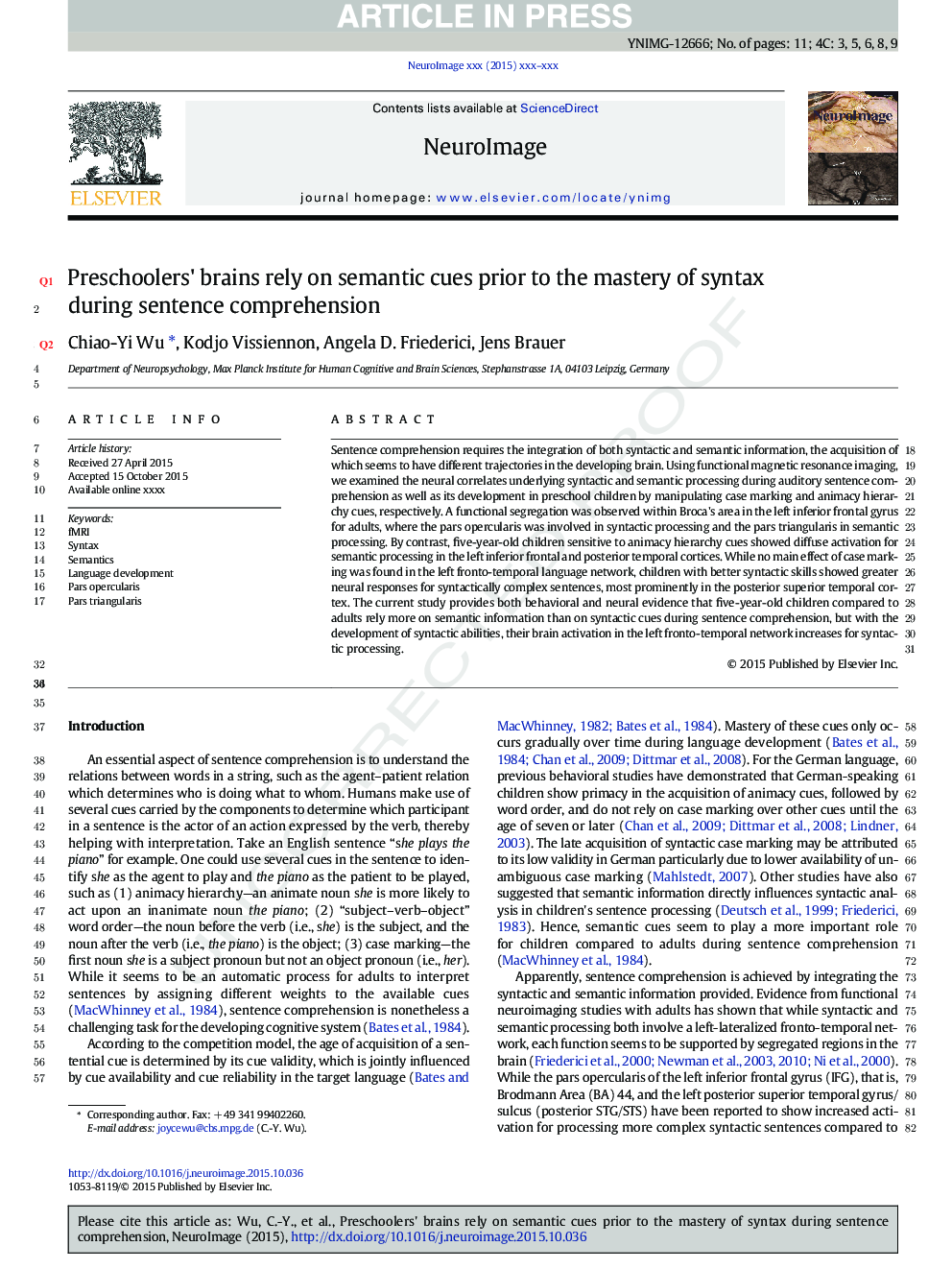| کد مقاله | کد نشریه | سال انتشار | مقاله انگلیسی | نسخه تمام متن |
|---|---|---|---|---|
| 6023920 | 1580882 | 2016 | 11 صفحه PDF | دانلود رایگان |
عنوان انگلیسی مقاله ISI
Preschoolers' brains rely on semantic cues prior to the mastery of syntax during sentence comprehension
ترجمه فارسی عنوان
مغز های پیش دبستانی به نشانه های معنایی پیش از تسلط بر نحو در درک مفاهیم حکایت می کنند
دانلود مقاله + سفارش ترجمه
دانلود مقاله ISI انگلیسی
رایگان برای ایرانیان
کلمات کلیدی
ترجمه چکیده
درک احضار نیاز به ادغام هر دو اطلاعات نحوی و معنایی دارد، که بدست آوردن آن به نظر می رسد مسیرهای مختلف در مغز در حال رشد دارد. با استفاده از تصویربرداری رزونانس مغناطیسی کارکردی، ما در بررسی پردازشهای نحوی و معناشناختی در حوزه درک شنوایی شنوایی و همچنین توسعه آن در کودکان پیش دبستانی با استفاده از نشانه های نشانه های مورد و نشانه سلسله مراتب متحرک، همبستگی عصبی را مورد بررسی قرار دادیم. جداسازی عملکردی در ناحیه بروکا در گریس فرونتال پایین سمت چپ برای بزرگسالان مشاهده شد، جایی که پارس پروکاریس در پردازش نحوی و پارادایس سه گانه در پردازش معنایی دخیل بود. در مقابل، کودکان پنج ساله که به نشانه سلسله مراتب متحرک حساس هستند، فعالسازی پراکنده برای پردازش معنایی در قشرهای پیشین و خلفی قشر پایین چپ را نشان دادند. در حالی که هیچ اثر اصلی علامت گذاری در مورد در شبکه زبان زبان چپ یافت نشد، کودکان با مهارت های نحوی بهتر، پاسخ های عصبی بیشتری را برای جملات پیچیده پیچیده نشان دادند، که بیشتر در قشر فوقانی قاعده پشتی دیده می شد. مطالعه حاضر، شواهد رفتاری و عصبی را فراهم می کند که کودکان پنج ساله در مقایسه با بزرگسالان بیشتر بر اطلاعات معنایی بیشتر از نشانه های نحوی در درک مفاهیم قضاوت می کنند، اما با توسعه توانایی های نحوی، فعال سازی مغز در شبکه های چپ فوری برای پردازش نحوی افزایش می یابد.
موضوعات مرتبط
علوم زیستی و بیوفناوری
علم عصب شناسی
علوم اعصاب شناختی
چکیده انگلیسی
Sentence comprehension requires the integration of both syntactic and semantic information, the acquisition of which seems to have different trajectories in the developing brain. Using functional magnetic resonance imaging, we examined the neural correlates underlying syntactic and semantic processing during auditory sentence comprehension as well as its development in preschool children by manipulating case marking and animacy hierarchy cues, respectively. A functional segregation was observed within Broca's area in the left inferior frontal gyrus for adults, where the pars opercularis was involved in syntactic processing and the pars triangularis in semantic processing. By contrast, five-year-old children sensitive to animacy hierarchy cues showed diffuse activation for semantic processing in the left inferior frontal and posterior temporal cortices. While no main effect of case marking was found in the left fronto-temporal language network, children with better syntactic skills showed greater neural responses for syntactically complex sentences, most prominently in the posterior superior temporal cortex. The current study provides both behavioral and neural evidence that five-year-old children compared to adults rely more on semantic information than on syntactic cues during sentence comprehension, but with the development of syntactic abilities, their brain activation in the left fronto-temporal network increases for syntactic processing.
ناشر
Database: Elsevier - ScienceDirect (ساینس دایرکت)
Journal: NeuroImage - Volume 126, 1 February 2016, Pages 256-266
Journal: NeuroImage - Volume 126, 1 February 2016, Pages 256-266
نویسندگان
Chiao-Yi Wu, Kodjo Vissiennon, Angela D. Friederici, Jens Brauer,
